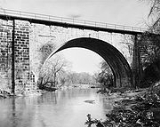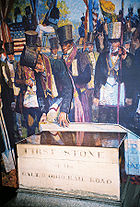
Carrollton Viaduct
Encyclopedia
The Carrollton Viaduct, located over Gwynns Falls
near Carroll Park in Baltimore, Maryland, is the first stone masonry
bridge built for railroad use in the United States
.
 The bridge is currently the world's oldest railroad bridge still in use, carrying loads far greater than originally envisioned. It was named after Charles Carroll of Carrollton
The bridge is currently the world's oldest railroad bridge still in use, carrying loads far greater than originally envisioned. It was named after Charles Carroll of Carrollton
, the last living signer of the Declaration of Independence and a director of the Baltimore and Ohio Railroad
, who laid the cornerstone
on July 4, 1828. As he laid the first stone he said, "I consider this among the most important acts of my life, second only to my signing the Declaration of Independence." Builder Caspar Wever and designer James Lloyd completed the structure for the railroad in November 1829, at an officially listed cost of $58,106.73. The actual cost of the construction may have been as high as $100,000.
The bridge, 312 feet (95 m) in length, rises from its foundations about 65 feet (20 m). It is 51 feet, 9 inches (15.8 m) above Gwynns Falls. It consists of a full-centered arch with a clear span length of 80 feet (24 m) over the stream, and a space for two railroad tracks on its deck. To provide an underpass for a wagon road, an arched passageway, 16 feet (5 m) in width, was built through one of the masonry-walled approaches. Originally planned as one arch of 40 feet (12 m) chord, the dimensions were enlarged to quiet the concern of the proprietor of the mills located immediately above the bridge site, who feared that 40 feet would be insufficient if the stream was flooded. The heavy granite
blocks which form the arches and exterior walls were procured from Ellicott's Mills
and Port Deposit
. A temporary wooden framework supporting the central span held 1,500 tons (1,360 tonnes) of this stone during construction. A white cornerstone at one end of the bridge bears the inscription "James Lloyd of Maryland, Builder A.D. 1829."
Andrew Jackson
, the first President of the United States to ride on a railroad train, crossed the bridge on a trip between Ellicott's Mills
and Baltimore on June 6, 1833. The Carrollton Viaduct has provided continual service to the Baltimore and Ohio Railroad and its modern corporate successor, CSX Transportation
.
The viaduct
was designated a National Historic Landmark
on November 11, 1971 and was automatically listed on the National Register of Historic Places
the same day.
In 1982 the viaduct was designated a Historic Civil Engineering Landmark by the American Society of Civil Engineers
.
Gwynns Falls
Gwynns Falls is a stream located in Baltimore County and Baltimore City, Maryland. The headwaters are located in Reisterstown in Baltimore County, and the stream flows southeast, entering the city of Baltimore and emptying into the Middle Branch of the Patapsco River. The Patapsco drains into the...
near Carroll Park in Baltimore, Maryland, is the first stone masonry
Masonry
Masonry is the building of structures from individual units laid in and bound together by mortar; the term masonry can also refer to the units themselves. The common materials of masonry construction are brick, stone, marble, granite, travertine, limestone; concrete block, glass block, stucco, and...
bridge built for railroad use in the United States
United States
The United States of America is a federal constitutional republic comprising fifty states and a federal district...
.

Charles Carroll of Carrollton
Charles Carroll of Carrollton was a wealthy Maryland planter and an early advocate of independence from Great Britain. He served as a delegate to the Continental Congress and later as United States Senator for Maryland...
, the last living signer of the Declaration of Independence and a director of the Baltimore and Ohio Railroad
Baltimore and Ohio Railroad
The Baltimore and Ohio Railroad was one of the oldest railroads in the United States and the first common carrier railroad. It came into being mostly because the city of Baltimore wanted to compete with the newly constructed Erie Canal and another canal being proposed by Pennsylvania, which...
, who laid the cornerstone
Cornerstone
The cornerstone concept is derived from the first stone set in the construction of a masonry foundation, important since all other stones will be set in reference to this stone, thus determining the position of the entire structure.Over time a cornerstone became a ceremonial masonry stone, or...
on July 4, 1828. As he laid the first stone he said, "I consider this among the most important acts of my life, second only to my signing the Declaration of Independence." Builder Caspar Wever and designer James Lloyd completed the structure for the railroad in November 1829, at an officially listed cost of $58,106.73. The actual cost of the construction may have been as high as $100,000.
The bridge, 312 feet (95 m) in length, rises from its foundations about 65 feet (20 m). It is 51 feet, 9 inches (15.8 m) above Gwynns Falls. It consists of a full-centered arch with a clear span length of 80 feet (24 m) over the stream, and a space for two railroad tracks on its deck. To provide an underpass for a wagon road, an arched passageway, 16 feet (5 m) in width, was built through one of the masonry-walled approaches. Originally planned as one arch of 40 feet (12 m) chord, the dimensions were enlarged to quiet the concern of the proprietor of the mills located immediately above the bridge site, who feared that 40 feet would be insufficient if the stream was flooded. The heavy granite
Granite
Granite is a common and widely occurring type of intrusive, felsic, igneous rock. Granite usually has a medium- to coarse-grained texture. Occasionally some individual crystals are larger than the groundmass, in which case the texture is known as porphyritic. A granitic rock with a porphyritic...
blocks which form the arches and exterior walls were procured from Ellicott's Mills
Ellicott City, Maryland
Ellicott City is an unincorporated community and census-designated place in Howard County, Maryland, United States. It is part of the Baltimore-Washington Metropolitan Area. The population was 65,834 at the 2010 census. It is the county seat of Howard County...
and Port Deposit
Port Deposit, Maryland
Port Deposit is a town in Cecil County, Maryland, United States. It is located on the north bank of the Susquehanna River near its discharge into the Chesapeake Bay...
. A temporary wooden framework supporting the central span held 1,500 tons (1,360 tonnes) of this stone during construction. A white cornerstone at one end of the bridge bears the inscription "James Lloyd of Maryland, Builder A.D. 1829."
Andrew Jackson
Andrew Jackson
Andrew Jackson was the seventh President of the United States . Based in frontier Tennessee, Jackson was a politician and army general who defeated the Creek Indians at the Battle of Horseshoe Bend , and the British at the Battle of New Orleans...
, the first President of the United States to ride on a railroad train, crossed the bridge on a trip between Ellicott's Mills
Ellicott City, Maryland
Ellicott City is an unincorporated community and census-designated place in Howard County, Maryland, United States. It is part of the Baltimore-Washington Metropolitan Area. The population was 65,834 at the 2010 census. It is the county seat of Howard County...
and Baltimore on June 6, 1833. The Carrollton Viaduct has provided continual service to the Baltimore and Ohio Railroad and its modern corporate successor, CSX Transportation
CSX Transportation
CSX Transportation operates a Class I railroad in the United States known as the CSX Railroad. It is the main subsidiary of the CSX Corporation. The company is headquartered in Jacksonville, Florida, and owns approximately 21,000 route miles...
.
The viaduct
Viaduct
A viaduct is a bridge composed of several small spans. The term viaduct is derived from the Latin via for road and ducere to lead something. However, the Ancient Romans did not use that term per se; it is a modern derivation from an analogy with aqueduct. Like the Roman aqueducts, many early...
was designated a National Historic Landmark
National Historic Landmark
A National Historic Landmark is a building, site, structure, object, or district, that is officially recognized by the United States government for its historical significance...
on November 11, 1971 and was automatically listed on the National Register of Historic Places
National Register of Historic Places
The National Register of Historic Places is the United States government's official list of districts, sites, buildings, structures, and objects deemed worthy of preservation...
the same day.
In 1982 the viaduct was designated a Historic Civil Engineering Landmark by the American Society of Civil Engineers
American Society of Civil Engineers
The American Society of Civil Engineers is a professional body founded in 1852 to represent members of the civil engineering profession worldwide. It is the oldest national engineering society in the United States. ASCE's vision is to have engineers positioned as global leaders who strive toward...
.
External links
- National Historic Landmark information
- National Register Information System (2003 write-up) - National Park Service
- National Register Information System (2002 write-up) - National Park Service
- American Society of Civil Engineers - Carrollton Viaduct
- Library of Congress HABS/HAER - Carrollton Viaduct
- Carrollton Viaduct, Baltimore City, including photo, at Maryland Historical Trust

